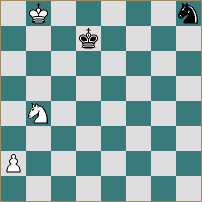Solution
1) White to play and win.
This solution is given in Genius in Chess (J. Levitt, 128 pages, Batsford, 1997, £12.99 ISBN 0 7134 8049 1)
The starting position is something I composed as an introduction to a discovery of John Nunn’s in 1995. Working on a computer database of knight and pawn against knight for his Batsford book, Secrets of Minor-Piece Endings, John unearthed a true gem:
1.gxh7
1.Rxh2? Rxg6! should only be a draw; 1.fxg7? Rxg6 is even ‘more’ drawn..
1 ... Ng6+
2.Rxh2 Rxh2
3.fxg7 Rxh7
4.g8Q Rh8
5.Qxh8 Nxh8.
We have reached John Nunn’s position which certainly deserves a diagram. Indeed, I think it deserves a place in chess history!.
 If you saw the next move here when solving the multiple choice question, having never seen this position before (it has been published as a study by Nunn), you may consider yourself a chess genius..
6.a3!!
Nunn and the database prove that this is the only winning move. The rather more natural 6.a4? Nf7 7.a5 Nd6 8.a6 Nb5 leads to a position of mutual zugzwang:
If you saw the next move here when solving the multiple choice question, having never seen this position before (it has been published as a study by Nunn), you may consider yourself a chess genius..
6.a3!!
Nunn and the database prove that this is the only winning move. The rather more natural 6.a4? Nf7 7.a5 Nd6 8.a6 Nb5 leads to a position of mutual zugzwang:
9.Kb7 (9.Nd5 Kc6 10.Nc3 Kb6!) 9...Nd6+ 10.Kb6 Nc8+ is equal..
6... Nf7
7.a4 Nd6
8.a5 Nb5
9.a6
Mutual zugzwang. Simplistically, White wants to play Kb7 when Black cannot respond with ....Nd6+. It is more complicated than that, but you can trust John Nunn - he’s a doctor (and knows how to use the database). One sample line and a few minutes thought should help convince you:.
9... Kd6
10.Kb7 Nc7
11.a7 Na8
12.Nd5! Kd7
Note that 12.Kxa8? Kc7! would have been drawn..
13.Nb6+
Aesthetically, it is better to present the pure knight and pawn position as a study rather than adding on my introduction. However, my version is certainly more difficult to solve with the turbulently flowing, violent sequence of the first five moves immediately followed by the astoundingly restrained 6.a3!!. The beauty of 6.a3 should excite you in some way. Most talented players are drawn to the depth, paradox, magic and mystery of such moves. As I have pointed out before, there is an aesthetic component to top players’ motivation..
The philosophers amongst you might like to ponder the questions: who really composed the position after Black’s fifth move, Nunn or the computer? Is it art, and who or what is the artist? What will be the significance of human/machine interactions in the future? Anyhow, I predict the position will become famous..
Top of this page Main page
Back to the 3 studies page
